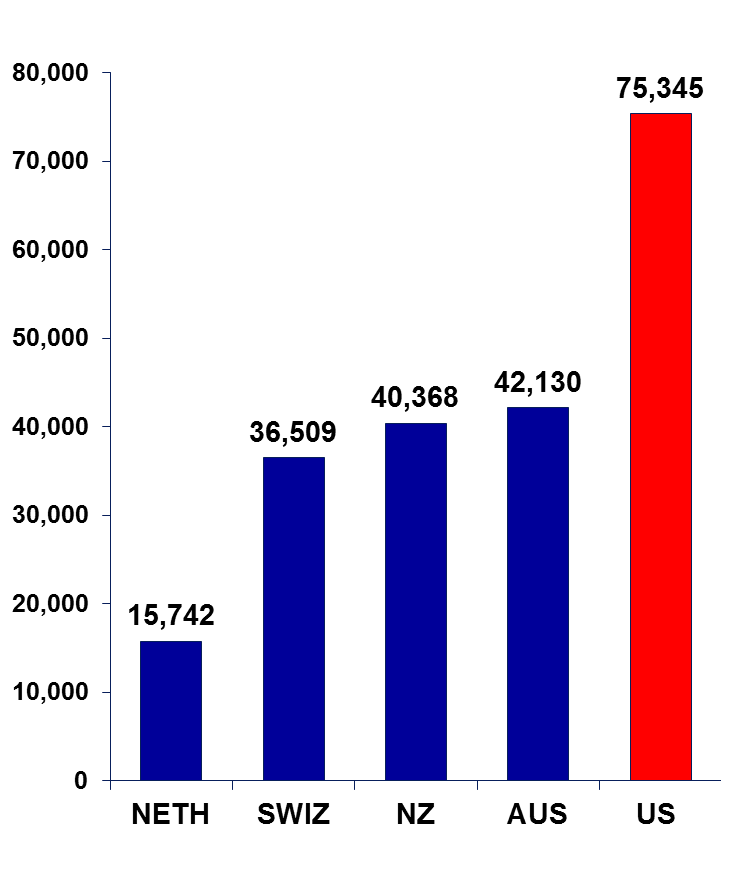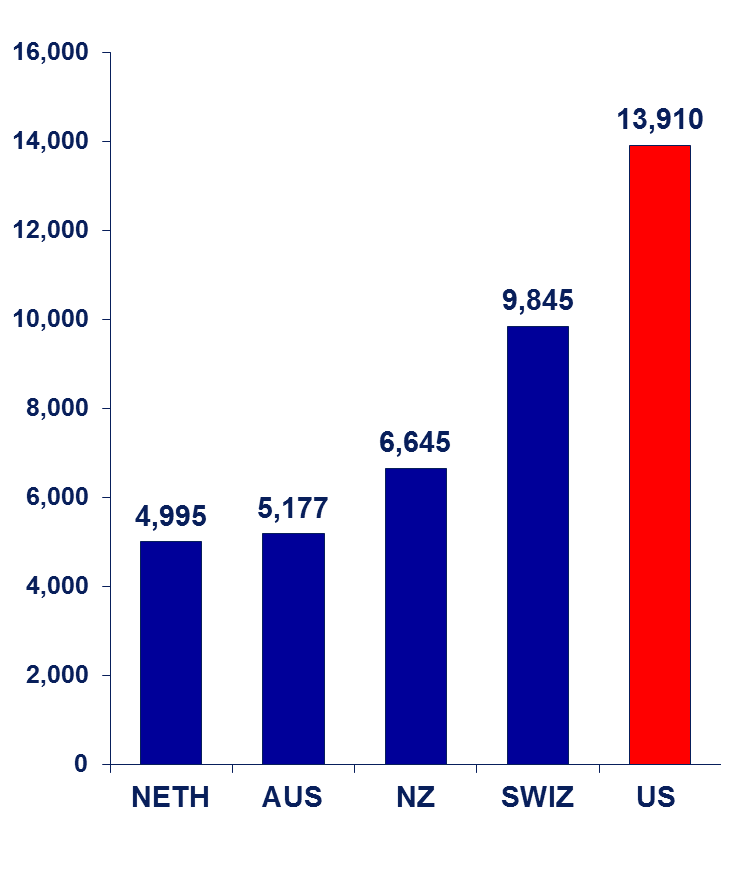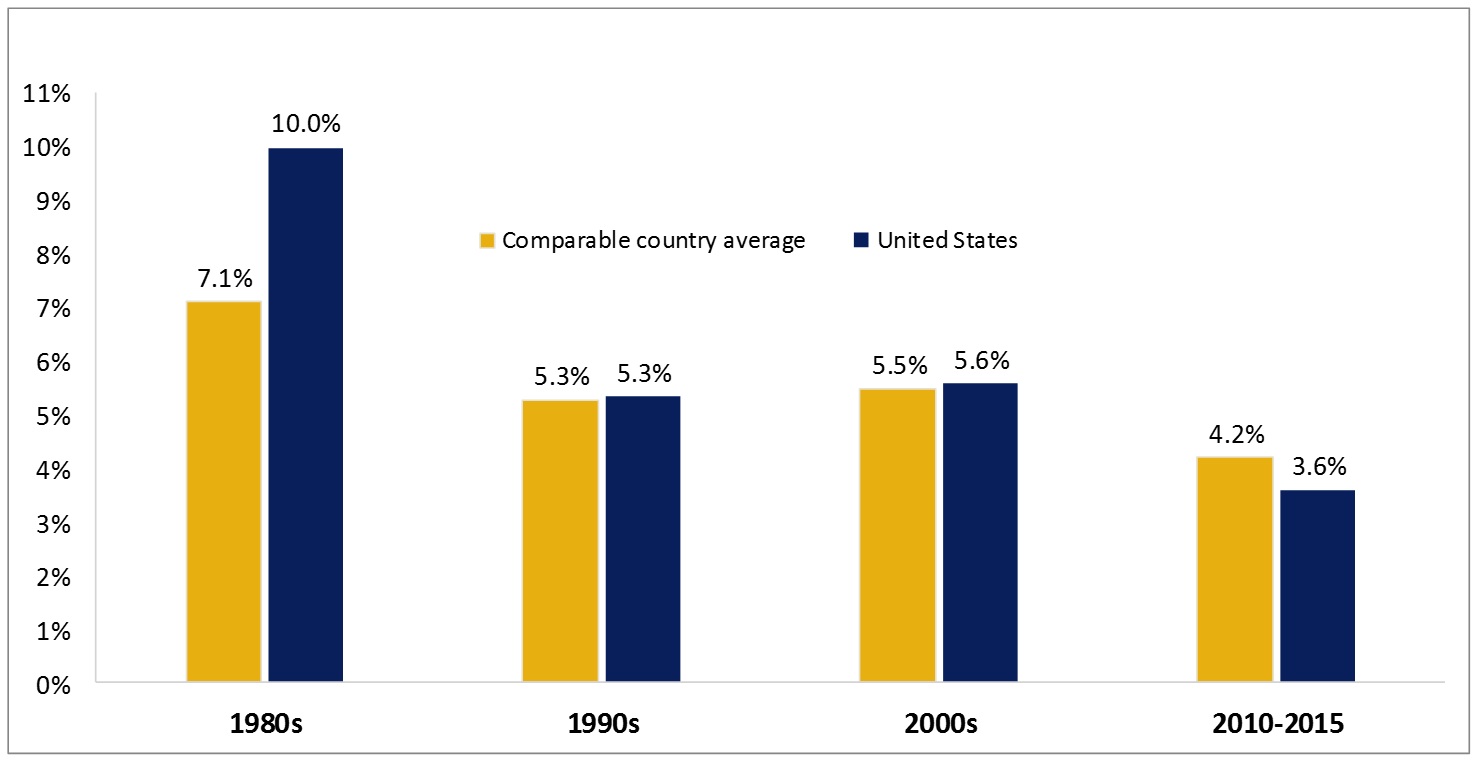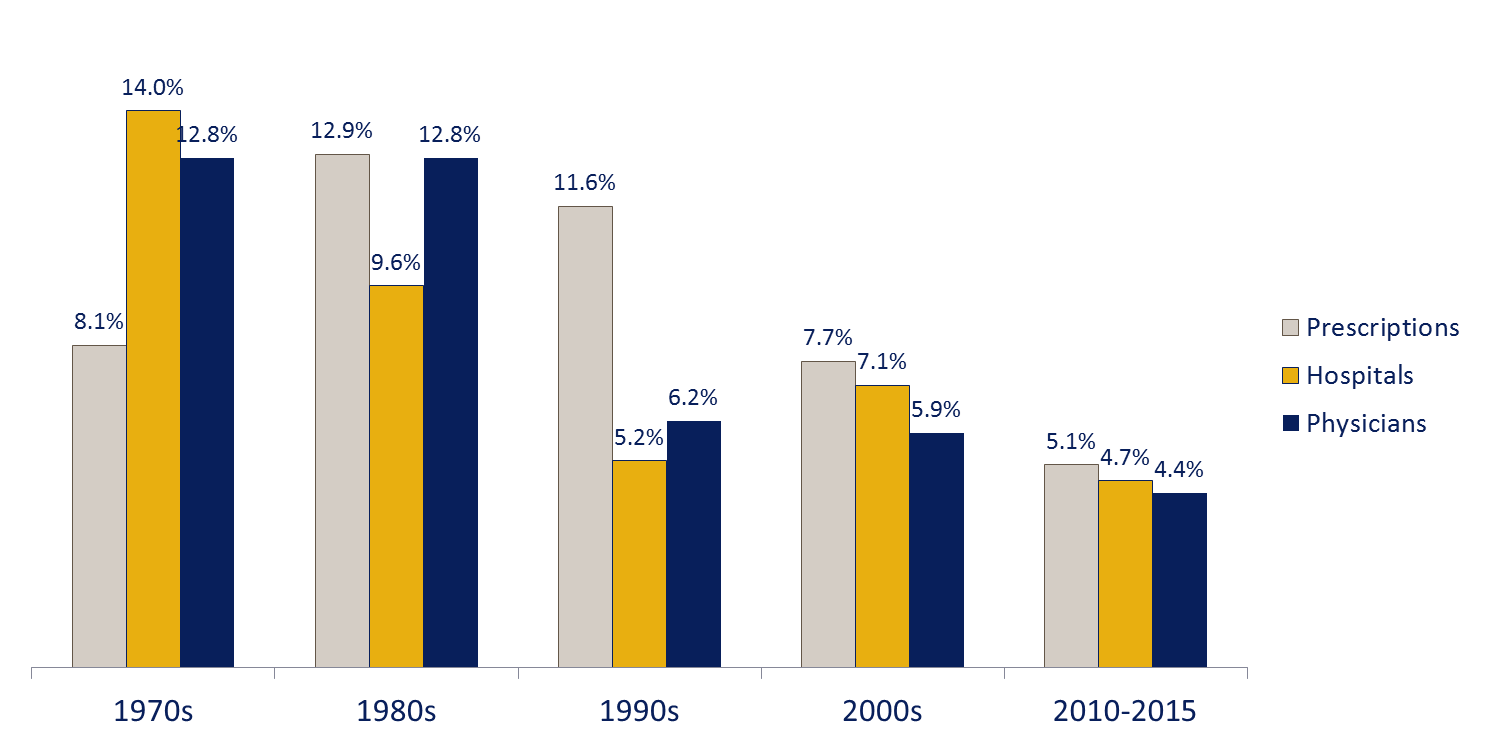Health Care Spending in the United States
BE 608
Start recording

Per capita health care spending in the US and OECD countries (source: OECD health Statistics)

Spending as % of GDP in the US and OECD countries (source: OECD health Statistics)
Total expenditures on health care are actually pretty simple:
how much does the care cost x how much do we use or:
Where Pi is the price of service i and Qi is the amount we consume.
Differences in expenditures over time or across countries must be driven by either Q, P, or a combination of both.
Why?
What is your explanation for why expenditures in the United States are so much higher than in other wealthy countries?
- Does this reflect higher "p" or high "q"?
Let's examine some specific hypotheses...
- Americans are richer, so we'd expect to spend more on all things, not just on health care. This is why health care spending is higher in the US.
- Americans are less healthy, and need more care/spending to achieve the same level of health as other countries.
Non healthcare reasons for higher spending:
Income and Spending


Percent age 65 and Older (OECD Health Data)

Percent daily smokers (OECD Health Data)

Percent obese, OECD Health Stats 2016

So what do we spend money on? (From 2018 NHE Data, KFF)
NOTE: Other Personal Health Care includes, for example, dental and other professional health services, durable medical equipment, etc.
Other Health Spending includes administration and net cost of private insurance, public health activity, research, and structures and equipment, etc.
Who is doing that spending?

Source: KFF
Who is doing that spending?
Mix of private and public payers
- Medicare: everyone age 65 and older plus the disabled
- Either directly by federal government or through privately contracted insurance companies
- Medicaid: certain low income groups (low income pregnant women, children, disabled)
- Either through federal/state partnership directly or through privately contracted insurance companies
- Employer sponsored health insurance
- Individual plans
- Self-pay

Spending on Insurance Administration per Capita

Pharmaceutical Spending per Capita

Number of prescriptions taken regularly


Price of selected drugs (monthly)


Practicing Physicians per 1000 Population

Annual physician visits per capita

Sample: Chronically ill adults
% who could get a same-day appointment if needed
Source: 2008 Commonwealth Fund International
Health Policy Survey of Sicker Adults

6+ days wait or never able
to get appointment

Survey of adults, 2013:
Easy getting after-hours care without
going to the ER
Source: 2008 Commonwealth Fund International Health Policy Survey

Survey of primary care physicians, 2012:
Practice has arrangement for patients’ after-hours care to see doctor or nurse


Average Physician Incomes
Primary Care
Orthopedic physicians
Laugesen and Glied, Health Affairs, (2011).
Average Physician Income by Age (includes business earnings)

Source: Gottlieb et al. NBER (2020)
Average Physician Income by Specialty (includes business earnings)

Source: Gottlieb et al. NBER (2020)

Physician Earnings, Selected Countries 2010
Cutler and Ly, Journal of Economic Perspectives (2011)

Hospital Discharges per 1000 population

Average Length of Stay for Acute Care

Spending per hospital discharge

Appendectomy

Bypass Surgery
Costs for Hospital Stay for Specific Surgical Procedures
Source: Commonwealth Fund; International Federation of Health Plans, 2013 Comparative Price Report

MRI Machines per million population

MRI exams per 1k population

CT Scans per 1000 population


Diagnostic Imaging Prices
MRI
CT Scan
| Prices | Quantities | |
|---|---|---|
| Administrative Costs | Higher | Much higher |
| Prescription drugs | Brand prices are much higher, but greater generic use | Slightly higher than average |
| Physician services (GP) | Higher | Lower |
| Physician services (specialists) | Higher | Higher for some procedures |
| Inpatient care | Higher | Fewer admissions, shorter length of stay, more intensive treatment |
| Diagnostic imaging | Higher | Higher |
Summary
How does the US compare to other countries in terms of...
Geographic Variation in Spending

McAllen TX: $13,648 per Medicare beneficiary
El Paso, TX: $8,714 per Medicare beneficiary
No clear difference in health outcomes.
Geographic Variation in Spending
What is correlated with this variation within the United States?
- Historical factors: Hill Burton hospital construction, nature of tort system in state
- Physician culture ("cowboys/cowgirls" vs "comforters"/"high follow up" vs "low follow up")
- Patient preferences and characteristics are not highly correlated
Cutler, Skinner, Stern, and Wennberg AEJ: Policy 2019
Geographic Variation in Spending

Cutler, Skinner, Stern, and Wennberg AEJ: Policy 2019
Geographic Variation in Spending
- Different regions have different cultures, fixed capital, and patient populations.
- They also have different policy environments, and appetites for intervention.
What has your state done (if anything) to curb health care spending?
Spending Growth
Health Spending as a Percentage of GDP, 1970–2017

Source: KFF and Peterson/Kaiser Health System Tracker (based on NHE data)

Historical growth by decade

Historical growth by decade, by category
Post 2010 Cost Slow Down: spending for those age 65+

"Bending the cost curve"
Cutler et al. Health Affairs 2019
Post 2010 Cost Slow Down
Cutler et al. Health Affairs 2019

Change in Expenditures Since COVID-19

Change in Expenditures Since COVID-19

Change in Expenditures Since COVID-19

Understanding Differences in Spending
•The US spends substantially more on health care than other high income countries.
•Although health care is a normal good, this higher spending cannot be explained by higher income in the US.
•Also, higher spending is not driven by greater health needs.
•Higher spending in the US is driven by higher prices and greater use of “high tech” interventions.
Challenges in the US

These Challenges are Tightly Connected

Rising costs have led to an erosion of insurance coverage
Over-utilization increases costs and harms patients
The uninsured often go without necessary care
So: Does the US Spend "Too Much"?
Upcoming Topics
•Is the level of health spending in the US inefficiently high?
•If technology drives the growth in health spending, how should we think about the efficient level of technology diffusion?
•How does insurance design influence the demand for and supply of health services? How can plan benefits and provider payments be designed to improve efficiency?
•How do payment/delivery reforms address inefficiencies in the US system?
For next class
Arrow, Garber and Skinner, Gawande articles:
•How can we apply the concepts of productive and allocative efficiency to health care?
State question:
Has your chosen state experienced an increase or decrease/stagnation in health care costs over the last decade? What factors do you think explain these changes in trends?
